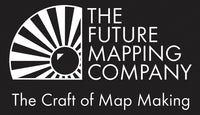Fortune Favours The Brave
The idea of Fortune Magazine may conjure up images of men in suits who think lunch is for wimps but when it was first launched, at the beginning of the Great Depression, it was something of a design pioneer.

Central to its ethos was a commitment to forward thinking illustrators and cartographers who could bring information to life across double page spreads and eye catching covers:
Here you can see an Antonio Petruccelli cover celebrating 4th July 1936. The first issue included a written design manifesto for how the magazine would be presented and, at one dollar an issue when other magazines only cost five cents.
The first issue included a written design manifesto for how the magazine would be presented and, at one dollar an issue when other magazines only cost five cents, it announced itself as a quality publication that encompassed everything from business to science, politics and culture.
Richard Edes Harrison was a designer who became a cartographer by chance when he was working at Time Magazine and was asked to fill in on sister publication Fortune. He thought his lack of official cartography training actually helped him make better maps has he had no preconceived ideas of what a map ‘should’ look like.



Fortune - The Land As We Use It | Fortune - Europe in the Sunset | Fortune - Texas Oil
His most important work for Fortune Magazine bridged cartography and art – with a series of images of the world during the Second World War that fused geographical, political and commercial interests and enabled the American public to understand their place in the war. These were later turned into “Look at the World: The Fortune Atlas for World Strategy” in 1944 which became a bestseller.
Harrison’s ‘Europe in The Sunset’ – a map of the resources available to Germany if they were to defeat the Allied blockade
This beautiful mix of cartography and illustration shows the breakdown of American agriculture.
In addition to Richard Harrison, Antonio Petruccelli, who illustrated many of Fortune’s early covers, also produced infogrammatic maps. “His covers and illustrations provided social commentary through the depiction of various aspects of American life, reflecting the social, economic and political atmosphere over several decades”.
For this map of Texas, he described “using some hundreds of coloured map pins to locate resources, industries [working] from a mass of detailed data… If you look closely some pin holes are visible in the repro.”
We love the story that, much later in life, he was cautioned by the police in his hometown of New Jersey for ‘defacing the covers of Fortune in an ephemera shop with his signature’.

Despite the years that have passed – Fortune continues to produce innovative maps. This globe shows a map of the fibre optic cables that carry information around the Internet, in fact they sort of are the Internet!
Interestingly, today the trading floors of Wall Street may be digital but they “have clustered around 60 Hudson Street, where the majority of transatlantic undersea cables land… to hear the news of faraway markets first, if only by a matter of milliseconds.”
Whilst we wouldn’t want to halt progress and the world must move on, we can’t help but mourn the passing of the age of beautifully hand illustrated maps and infograms – ones where you can imagine Harrison and Petruccelli hunched over their drawings bringing the humanity to information.
We would like to offer special thanks to Dr Chris Mullin’s website ‘The Visual Telling of Stories’ and his online library of Fortune Magazine information which is a true labour of love and inspired this piece.



